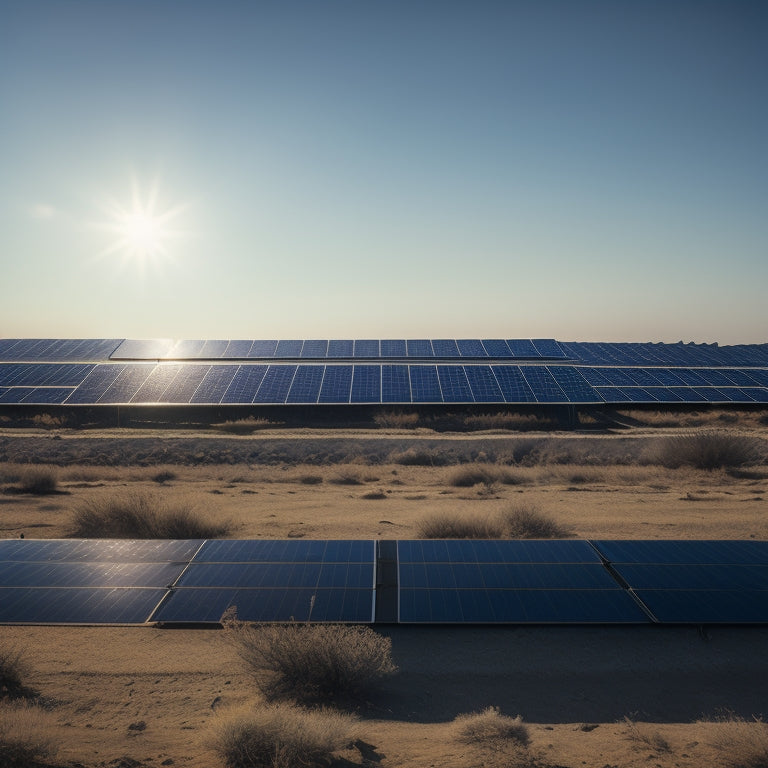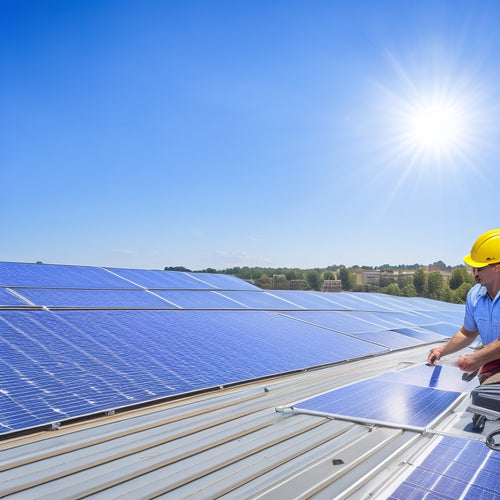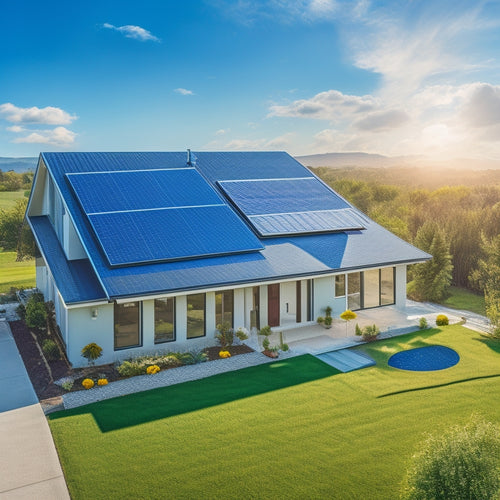
Why Regular Maintenance Matters for Solar Panels
Share
You invested in solar panels to harness renewable energy, but without regular maintenance, their performance will dwindle. Dust accumulation can reduce energy production by up to 25%, while loose connections and inverter issues can lead to energy losses and failures. Cleaning your panels every six months, checking connections, and monitoring inverter performance are essential to maintaining peak output. Additionally, inspecting for signs of wear, trimming nearby vegetation, and preventing pest infestations are important for peak energy production. By staying on top of maintenance, you'll avoid downtime and guarantee your solar panels operate at their best - and there's more to explore to get the most out of your investment.
Key Takeaways
• Regular maintenance ensures optimal energy production by removing dust, debris, and other obstacles that reduce panel efficiency.
• Loose connections and inverter issues can lead to energy losses and failures, making regular checks crucial for peak performance.
• Proper panel angle and tilt maintenance maximize energy output, and adjustable racking systems can further optimize performance.
• Regular inspections help identify signs of wear, tear, and pest infestation early, preventing downtime and maintaining peak energy production.
• Vegetation trimming and shading prevention are essential to ensure unobstructed sunlight reaches solar panels, resulting in optimal energy generation.
Inspect for Debris and Dirt
During regular solar panel maintenance, start by inspecting the panels for debris and dirt that can greatly diminish their energy output. As you inspect, pay attention to dust accumulation, which can reduce energy production by up to 25%.
Even a thin layer of dust can have a significant impact, so it's important to clean your panels regularly.
In addition to dust, water spots can also hinder energy production. When water evaporates from the surface of your panels, it can leave behind mineral deposits that block sunlight. These spots can be particularly problematic in areas with hard water, so it's crucial to clean your panels regularly to prevent mineral buildup.
To clean your solar panels effectively, use a soft-bristled brush and a mild soap solution. Avoid using harsh chemicals or abrasive materials that can scratch the panels.
Check for Loose Connections
When you're checking your solar panels, don't forget to inspect the connections. Loose connections can lead to energy losses and even system failures, so it's crucial to identify and tighten any loose fittings.
Tightening Loose Fittings
You should regularly inspect and tighten any loose fittings or connections on your solar panels to guarantee peak energy production and prevent potential safety hazards. Loose connections can lead to energy losses, overheating, and even electrical shocks. Additionally, weather resistance is essential for outdoor installations, and ensuring tight fittings helps maintain the system's integrity.
When inspecting your solar panels, look for signs of wear and tear, corrosion, or damage on the hardware. Check for loose screws, bolts, or clips, and tighten them according to the manufacturer's specifications. Consider upgrading your hardware to enhance weather resistance and prevent future issues.
Regular tightening of loose fittings will also help you identify potential problems early on, allowing you to address them before they escalate into major issues. By doing so, you'll ensure your solar panels operate at peak levels, providing you with a reliable and efficient source of power.
Inspecting Connection Points
Every few months, inspect the connection points between your solar panels and the mounting system, as well as the connections to the inverter and other system components, to identify and tighten any loose connections. This important step guarantees that your solar panel system operates at peak efficiency and reduces the risk of electrical faults.
Loose connections can lead to corrosion risks, which can compromise the integrity of your system. Make sure to check that all connections meet the relevant wiring standards, such as those set by the National Electric Code (NEC).
When inspecting, look for signs of wear, corrosion, or overheating, which can indicate loose connections. Tighten any loose connections you find, and consider replacing damaged or corroded components.
Verify Panel Angle and Tilt
When verifying your solar panels' angle and tilt, you'll want to confirm they're optimized for maximum energy production. You'll need to calculate the best angle based on your location and panel orientation, and then check that it matches the actual installation.
Optimal Angle Calculation
Calculating the best angle for your solar panels involves confirming both the tilt and orientation to guarantee maximum energy harvest. You want to make sure your panels are positioned to capture the most sunlight possible, and that means adjusting the angle and azimuth to suit your location. An ideal angle calculation takes into account factors like latitude, time of year, and surrounding obstacles that could cast shade.
To get it right, you'll need to perform a shading analysis to identify potential obstructions, such as trees or buildings, that could impact energy production. This will help you determine the best angle and orientation for your panels.
An azimuth adjustment may be necessary to ensure your panels are facing the best direction. By making these adjustments, you can maximize your energy output and get the most out of your solar panel system. Remember, even small adjustments can make a significant difference in your energy harvest.
Panel Orientation Check
You should regularly inspect your solar panels to confirm that their angle and tilt are optimized for maximum energy production. This is important because even a slight deviation from the ideal orientation can have a noticeable impact on your system's performance.
A thorough panel orientation check involves reviewing your panel's history to identify any potential issues that may have arisen during installation or over time.
Take note of any changes in your roof's structure or surrounding environment that could be affecting your panels' angle and tilt. Consider investing in orientation innovations, such as adjustable racking systems or trackers, to make sure your panels are always facing the best direction. These advancements can greatly boost your energy output, especially if you live in an area with variable sunlight patterns.
Seasonal Adjustments Needed
As the seasons change, your solar panels' angle and tilt may need adjusting to guarantee maximum energy production, especially if you live in regions with distinct seasonal variations in sunlight patterns. You'll want to optimize your panel's orientation to capture the most sunlight, ensuring you're harvesting energy efficiently.
During climate shifts, the sun's path across the sky changes, affecting the angle of incidence on your solar panels. To maximize energy harvest, you should adjust your panels' tilt and angle accordingly.
For instance, during winter, you may need to tilt your panels more steeply to compensate for the lower sun angle. Conversely, during summer, a shallower tilt can help prevent overheating.
Clean the Solar Panels
Every six months, dust and debris accumulated on the solar panels' surface should be removed to maintain peak energy output. You'll want to clean your solar panels regularly to guarantee maximum energy production. A dirty solar panel can reduce energy output by up to 25%, which can add up to significant losses over time. Cleaning your solar panels is a simple process that requires minimal equipment: a hose, a soft-bristled brush, and some mild soap. Be sure to turn off your solar panel system before cleaning to avoid any electrical shock.
When cleaning your solar panels, you're not only increasing energy output, but you're also doing your part for the environment. By maximizing energy production, you're reducing your reliance on non-renewable energy sources, which in turn reduces your environmental impact. Additionally, using a hose to clean your solar panels conserves water through efficient use.
Inspect for Signs of Wear
Regular visual inspections of your solar panel system can help identify potential issues before they cause significant energy losses or system failures. When you inspect your system, look for signs of wear and tear that can affect its performance. Check for loose connections, cracks, or broken glass in your panels.
Also, inspect the mounting system and tracking mechanisms for any signs of rust or corrosion. Conducting a Corrosion Analysis can help you identify areas that need attention. Material Degradation can lead to a significant decrease in energy output, so it's crucial to catch it early.
Inspect the wiring and electrical components for frays, cracks, or damage. Additionally, check the panel's frames, clamps, and fasteners for signs of rust or corrosion.
Check Inverter Performance
You should monitor your inverter's performance data regularly to make sure it's operating within the specified parameters and identify any potential issues that could be affecting your solar panel system's overall energy output. This is important because inverter efficiency directly impacts the amount of power your system produces. By tracking your inverter's performance, you can detect anomalies that might be reducing your system's energy output.
Check your inverter's monitoring frequency to make sure it's set to provide you with accurate and timely data. You don't want to be caught off guard by a sudden drop in performance. Set a schedule to review your inverter's performance data regularly, so you can identify and address any issues promptly. This proactive approach will help you maintain peak inverter efficiency, ensuring your solar panel system operates at its best.
Trim Nearby Vegetation
To guarantee shading prevention and secure peak energy production, trim any nearby trees or vegetation that could be encroaching on your solar panels. Overgrowth consequences can be severe, reducing your system's efficiency and ultimately, your energy output. As a solar panel owner, it's crucial to implement effective tree pruning strategies to maintain peak performance.
Regular trimming helps prevent leaves and branches from casting shadows on your panels, which can greatly reduce energy production. Overgrown vegetation can also accumulate debris, such as leaves and twigs, which can further compromise your system's performance.
Check for Pest Infestation
Pests like rodents, birds, and insects can cause significant damage to your solar panels by chewing on wires, nesting under panels, and leaving debris that blocks sunlight. As a solar panel owner, it is crucial to check for pest infestation regularly to prevent damage and maintain peak energy production.
Here are some common signs of pest infestation to look out for:
| Pest | Signs of Infestation | Damage Caused |
|---|---|---|
| Rodents | Chew marks on wires, droppings near panels | Wire damage, electrical issues |
| Birds | Nesting materials under panels, bird droppings on panels | Debris accumulation, reduced energy output |
| Insects | Insect bodies or wings near panels, burrows in surrounding soil | Clogged panel surfaces, reduced energy output |
To prevent pest infestation, consider installing rodent guards, bird-repellent balloons, and using insect-repellent coatings on your solar panels. Regularly inspect your solar panels for signs of pest infestation and address any issues promptly to maintain peak energy production.
Schedule Regular Inspections
Regular inspections are crucial to identifying potential issues before they escalate into major problems, and scheduling them in advance guarantees that your solar panels receive the routine maintenance they need to operate at peak performance. By doing so, you'll catch minor issues before they become major headaches, saving you time and money in the long run.
When scheduling inspections, it's important to keep a record of each maintenance session. This record keeping will help you track any recurring issues, monitor the effectiveness of previous repairs, and identify areas for improvement. A well-maintained record also enables you to plan for future maintenance, ensuring that your solar panels continue to operate efficiently.
Effective maintenance scheduling is key to maximizing your solar panel's energy output. By staying on top of inspections, you'll minimize downtime and guarantee that your system operates at its best levels. Remember, a well-maintained solar panel system is a powerful one – and regular inspections are the key to unlocking its full potential.
Frequently Asked Questions
How Often Should I Inspect My Solar Panels for Optimal Performance?
You should inspect your solar panels quarterly to prevent panel degradation, which can lead to energy loss; regular checks guarantee peak performance, saving you money and maximizing your renewable energy output.
What Is the Ideal Cleaning Solution for Solar Panels?
When cleaning your solar panels, you'll want to use a mild, environmentally friendly solution like deionized water and a soft-bristle brush to minimize environmental impact and guarantee peak energy production.
Can I Clean My Solar Panels During the Day or at Night?
"Can you afford to lose power? Cleaning solar panels during the day risks reducing energy output due to Daytime Reflection, while Nighttime Cooling allows for more efficient cleaning, so choose wisely."
How Do I Know if My Solar Panels Are Installed at the Correct Angle?
To determine if your solar panels are at the correct angle, you'll need to take into account your roof's orientation and utilize an Angle Calculator to guarantee peak energy production, maximizing your power output.
What Is the Average Lifespan of a Well-Maintained Solar Panel System?
'As you soak up solar savings, you'll be thrilled to know that a well-maintained system can last up to 30 years or more, ensuring peak solar panel durability and maximizing energy output with minimal degradation.'
Related Posts
-

What Does Solar Panel Maintenance Really Cost?
You can expect to pay between $1,500 to $2,500 per year for solar panel maintenance, with costs influenced by your sy...
-

5 Best Steps to Installing Solar Panels at Home
You're about to start on a journey to harness the power of solar energy at home. First, assess your home's solar pote...
-

Why Go Solo in Urban Transportation?
You're taking control of your daily commute by ditching the crowds and going solo, and that's a smart move. By choosi...


